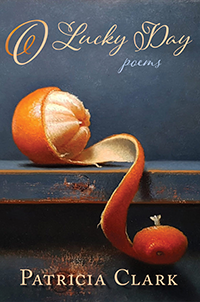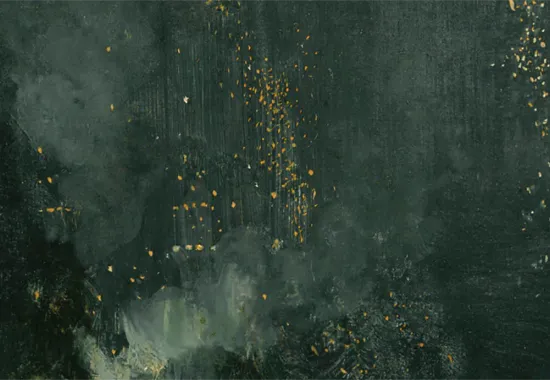Clark O Lucky Day
Wallace Stevens was right when he claimed in “Sunday Morning” that “Death is the mother of beauty,” and Gerard Manley Hopkins was right when he implied in “Spring and Fall” that all of our grieving manifests from our knowledge of our own mortality. Together, these understandings pervade Patricia Clark’s sixth collection, O Lucky Day. The book is an examination of mortality and grief, of relinquishing the things of this world with grace if also sorrow, of the tenderness with which the human and more-than-human elements of creation might be received. In these poems, the speaker pays close attention to the quotidian—pollen, sea urchins, clementines—understanding that their value emerges in part through their ephemeral natures. The poems are also populated by friends and relatives, often deceased, as well as by a very-much-alive (for now, not forever) husband.

O Lucky Day is arranged into three sections preceded by a single prefatory poem. In the first section, the poems consider the necessity of letting go rather than grasping after creatures and objects that cannot last. Words and phrases like “release” and “let it go” and “yields” show up frequently. Without exoticizing the material, several of the poems in this section rely on references to Japanese vegetation and culture for their content. The second section consists of a single poem, “Wrack Line,” organized into several sections, with each section formally different from the others. This poem explores a specific environment and clearly falls within the category of ecopoetry, those poems that examine nature through the lens of environmental crisis. The final section includes several ekphrastic poems that respond to music as well as visual art, and these poems reflect on others in the section, prompting readers to interpret other objects as works of art. Throughout the collection, Clark exhibits a mastery of form, in the narrow sense of received forms, traditional stanza types, and strategies of lineation, but more importantly through her choices from one poem to the next, identifying the most effective form, whether free or formal verse, for each poem. There’s an impressive formal variety here, handled so adeptly that readers often don’t recognize the full range until they step back and look at how differently the poems appear on the page.
The prefatory poem, “Oxygen: Letter to My Husband After a Quarrel,” illustrates Clark’s sense of form and also hints at several of the collection’s themes. The poem is arranged into couplets, with each second line indented. As in several of the other poems, Clark relies here on repetition as an organizing device, repeating “I’m sorry” in several lines. In this poem, the repetition doesn’t quite rise to the level of anaphora, as it does in some of the others, but even here Clark reveals an effective intuition about when and where to introduce variation within the repetition. Despite the title and the opening phrase, “I’m sorry,” the poem isn’t actually an apology to the speaker’s husband, but an expression of regret for many things, including her own behavior, yes, but also the ways of the world—people contract illnesses, people choose one activity rather than another, people build dams on rivers that interfere with spawning fish. We’re nearly halfway through the poem before we read, “I’m sorry I’m bossy and can’t sit / still.” A couple of lines later, she moves closer to a real apology, but even here her language is conditional: “If I’ve hurt you, / I’m sorry.” By the end of the poem, however, readers know that this sentence isn’t one of those non-apology apologies we hear so often from celebrities and politicians. The regret she’s expressed up to this point is more like concern for others, her mother who “got a blood clot in her lung” and her father with whom she “never went fishing” despite “the fly rod he gave me gather[ing] dust.” She returns to that detail, converting it to metaphor, at the end of the poem, after she has described her relationship with her husband as “yin / and some yang, some oil, some / / water.” The rhythm of this phrasing is attractive, and it also conveys the speaker’s patience with herself, her husband, and the imperfect yet appreciative relationship they’ve created. She’ll learn to attract fish, but “I won’t bring / a steelhead home. They’re a gift: catch // and release, kiddo. I’m trying to learn how.” This poem seems to meander toward its conclusion, until it gets there, clicking shut as good poems do, and readers realize that every detail has contributed to the poem’s effect.
One of my favorite poems in the collection is “Love Poem to a Red Fox,” which consists of a long series of sentence fragments, each beginning with “To your” or “To whatever” or “To the.” This strategy could easily grow dull and predictable, but Clark prevents that by varying the length of items in her lists and by selecting memorable detailed language and unexpected observations. Here are the opening lines: “To your black-stockinged feet as you trot west. / / To your bushy tail streaming behind you like a flame.” The fox’s tail and paws, along with perhaps his muzzle, are a fox’s most salient characteristics, ones that come to mind most easily for many readers, so it is prudent for Clark to begin here; she defers more surprising content until later in the poem, when the lull of anaphora might suggest there’s little surprise to be had. Even in these opening lines, however, Clark extends her descriptions with language that is both visually and sonically interesting. The consonance of “trot west,” for example, perks up the reader’s ear, and the phrase functions as a spondee, its beat insistent even in this free verse poem. Later, Clark relies on equally attractive language to describe less attractive aspects of the animal: “To the musky scent you leave as you pass, one to drive / the neighborhood dogs wild, howling. / / To your scat with a tapered tail with embedded bits of mouse, / rabbit, berries, or insects, bird feathers too.” Finally, the poem grows almost ecstatic, celebrating this animal body which the speaker can celebrate only because she too is enfleshed: “To the chance of you, risk of you, joy of you red against the snow.”
Throughout O Lucky Day, Clark demonstrates an ease with the elements of poetic craft. The language is utterly under her control, and yet it also feels relaxed. Her wide stylistic range is accompanied by an impressive thematic depth. The poems invite readers into an appreciation for the world and our brief lives within it, even as they also show us the necessity of letting go.
Recommended
A Review of Jim Reese's Coming to a Neighborhood Near You
Nonstop Flights: Review of The Flight from Meaning by Stephen Haven
Review: Lanterns in the Night Market by Mary Morris






